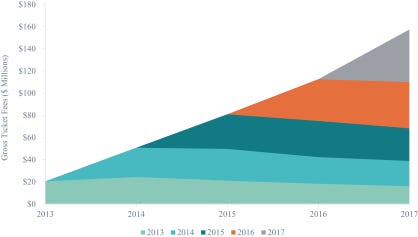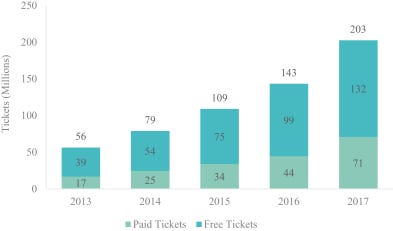Measuring ecommerce health & metrics
For any B2C business, cohort performance is critical. A cohort is a set of customers acquired during a certain time period — for instance the January 2018 cohort is all customers acquired in January 2018. Key metrics in evaluating cohort performance include looking at the marketing spend it took to acquire the cohort, the amount of money that cohort spends on their first purchase (initial revenue), and the amount of money that cohort has spent since that first purchase (retention rates or repeat revenue). The goal of any growing B2C business is to have cohorts that are profitable after accounting for the cost of acquiring them.
Eventbrite, which went public in 2018, provides good examples of cohort metrics. Eventbrite is a platform which helps you create, plan, and produce a live event. They make money on each ticket you sell to your live event. According to their S1, “in 2017, we helped more than 700,000 creators issue approximately 203 million tickets across approximately three million events in over 170 countries.” Net revenue (ticket fees) was $202mm in 2017, up from $133mm in 2016. Specific measures of their business, which can be applied to any B2C business, are below.
Initial revenue of a cohort. Eventbrite tracks the initial fees collected from a new cohort, and as you can see, it’s growing which is the trend you want. “The gross ticket fees we have generated for the first year of each creator cohort has more than doubled from 2013 to 2017. Gross ticket fees of each creator cohort in year one are set forth below:”

Retained revenue of a cohort. As importantly, Eventbrite needs to make sure the cohort keeps coming back and spending with them. “We have demonstrated a consistent track record of retaining gross ticket fees from creator cohorts over time. For example, we retained 78% of the gross ticket fees from our 2013 creator cohort in 2017.” As impressive, their net retention from the prior year is a whopping a 97% (calculated as Measurement Year Gross Ticket Fees divided by the Prior Year Gross Ticket Fees).

Freemium versus paid users. Eventbrite has a free product and paid product. If your business has a similar freemium model, it’s important to see the blend of paid versus free users. As you can see, Eventbrite’s paying users are growing and according to their S1 “Our success in serving creators is measured in large part by the number of tickets that generate ticket fees for us. We consider this an important indicator of the underlying health of the business. We refer to these tickets as paid tickets.”

Eventbrite is a B2C business which does a wonderful job of showing us the key metrics to monitor for any B2C business. Cohort performance is critical, and if you measure your numbers the way Eventbrite does, so long as the trends hold strong, you’ll be well on your way to going public like they did.
Visit us at blossomstreetventures.com and email us directly with Series A or B opportunities at . We invest $1mm to $1.5mm in growth rounds, inside rounds, and other ‘special situations’ all over the US & Canada.